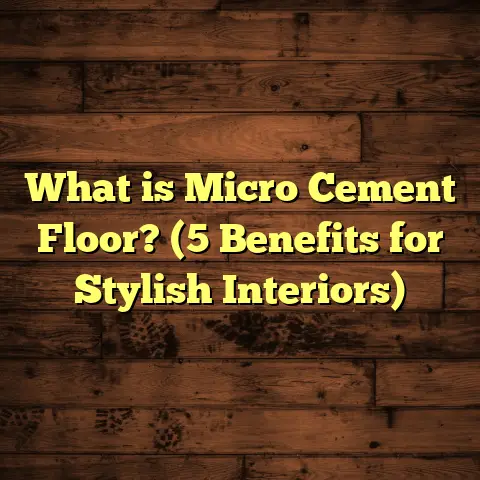What is Wood Flooring? (5 Key Benefits & Types Explained)
Wood Flooring: What Is It and Why Does It Matter?
Let me start by talking about kids. If you have children, you probably know how much they move around — running from room to room, playing games on the floor, sometimes crawling or sitting there while drawing or reading. The floor is not just a part of your house; it’s part of their daily environment. It needs to be safe, comfortable, and durable enough to handle all that energy. And that’s exactly why wood flooring has always been fascinating to me. It combines natural beauty with strength and warmth in a way few other materials can match.
Now, before you think wood flooring is just about pretty planks of wood, there’s actually a lot more going on behind the scenes. So, what is wood flooring exactly? Let me explain.
What Is Wood Flooring?
Wood flooring refers to floors made from timber that has been processed into planks or boards and used as a walking surface inside buildings. Unlike synthetic materials such as vinyl or laminate, wood flooring is made from natural wood harvested from trees.
The two main categories of wood flooring are:
- Solid Hardwood Flooring: Made from a single piece of solid wood cut directly from logs.
- Engineered Wood Flooring: Made from multiple layers of wood pressed together under heat and glue, with a hardwood veneer on top.
Solid Hardwood Flooring
Solid hardwood is the classic form of wood flooring. Think of it as a thick plank—usually around 3/4 inch thick—cut from a single piece of wood. Common species include oak, maple, hickory, cherry, and walnut. The planks are cut using different methods such as plain sawing, quarter sawing, or rift sawing:
- Plain sawn produces a distinctive grain pattern with “cathedral” arches.
- Quarter sawn yields straighter grain lines and greater stability.
- Rift sawn creates tight grain and a uniform appearance.
The thickness allows for sanding and refinishing multiple times over the floor’s lifespan.
Engineered Wood Flooring
Engineered wood flooring consists of several layers:
- The top layer is a thin veneer of real hardwood (anywhere from 0.6 mm to 6 mm thick).
- Beneath it are multiple layers of plywood or high-density fiberboard (HDF), glued together with grains running in opposite directions.
This cross-layering gives engineered wood greater dimensional stability, making it less prone to expanding or contracting with humidity changes. Typically, engineered wood planks are between 3/8 inch to 3/4 inch thick overall.
Manufacturing Process of Wood Flooring
Understanding how wood flooring is made helps appreciate its qualities better.
For Solid Hardwood
- Log Selection: High-quality hardwood logs are selected based on species, age, and straightness.
- Sawing: Logs are processed into boards using sawmills. The method affects grain pattern and stability.
- Drying: Boards are kiln-dried to reduce moisture content to around 6-9%, matching indoor conditions.
- Planing & Sanding: Surfaces are smoothed to prepare for finishing.
- Cutting to Length: Boards are cut into standard lengths (typically 2-8 feet).
- Finishing: Some floors come pre-finished with multiple coats of polyurethane or oil-based finishes; others are finished on-site after installation.
For Engineered Wood
- Veneer Production: Thin sheets of hardwood veneer are sliced or peeled from logs.
- Core Layer Prep: Plywood or HDF layers are prepared with precise thicknesses.
- Layer Assembly: Veneer and core layers are glued together under heat and high pressure.
- Cutting & Profiling: Multi-layered planks are cut to size and profiled for tongue-and-groove edges.
- Finishing: Similar to solid hardwood floors.
My Personal Journey with Wood Flooring
When I installed solid oak hardwood in my living room five years ago, I wasn’t just thinking about aesthetics—I thought about my kids playing on it every day. The first thing I noticed was the warmth underfoot compared to cold tile or laminate floors we’d had before. The texture was smooth but with enough grain for traction so they wouldn’t slip easily during their games.
Over time, little scratches appeared—from toy cars, shoes, and occasional spills—but instead of ruining the look, they added character. The floor aged gracefully, showing its history through these marks.
I also learned that regular maintenance was simpler than I expected—just sweeping regularly and using a damp mop once in a while kept it looking great. Plus, knowing I could refinish it years down the road made me feel confident it was a long-term investment.
5 Key Benefits of Wood Flooring
1. Durability and Longevity
Wood floors can take a beating and still last decades—sometimes generations. Solid hardwood flooring can often be sanded and refinished up to 10–12 times over its lifetime according to the National Wood Flooring Association (NWFA). Refinishing removes surface damage like scratches or stains and restores the original beauty.
Engineered wood floors also offer good durability but generally can be refinished fewer times due to the thinner top veneer layer—usually 1-3 times depending on thickness.
I’ve seen homes where the original hardwood floors were laid nearly 100 years ago still in use today after multiple refinishes—a testament to their durability.
The Janka hardness scale rates species by resistance to denting:
| Species | Janka Hardness (lbs) |
|---|---|
| Hickory | 1820 |
| White Oak | 1360 |
| Red Oak | 1290 |
| Maple | 1450 |
| Pine (Soft) | 420 |
This scale helps you pick a species based on expected wear and tear—especially important if you have active kids or pets.
2. Natural Beauty and Warmth
Wood floors bring natural warmth unmatched by tile or stone. The grain patterns create unique visuals in every plank—no two boards look alike.
I remember telling a client that wood floors have texture you can feel as well as see—there’s an emotional connection that goes beyond functionality. That warm feeling can make a room feel cozy and inviting immediately.
Did you know homes with hardwood floors tend to sell faster? A study by the Real Estate Staging Association found homes staged with hardwood floors sold approximately 6% faster than those without them.
The color palette available for wood flooring is vast—from pale blonde maples to deep reddish cherry or dark walnut—offering options for any style you want.
3. Healthier Indoor Air Quality (IAQ)
One big concern for families I work with is indoor air quality—especially those with kids who have allergies or asthma.
Unlike carpets that trap dust mites, pollen, pet dander, and other allergens, wood flooring is easier to keep clean and doesn’t harbor allergens as much.
Research published in the Journal of Allergy and Clinical Immunology showed that households with hard surface flooring had significantly lower allergen levels compared to carpeted homes.
In one project involving a family with severe allergies, switching from wall-to-wall carpet to engineered hardwood dramatically reduced allergy symptoms within months—something that made a huge difference in their quality of life.
4. Easy Maintenance
Wood floors are relatively low maintenance compared to other options like carpet or stone tiles.
Regular sweeping or vacuuming removes dirt before it scratches the finish. Damp mopping with mild cleaners keeps surfaces clean without damaging the finish.
Avoid harsh chemicals or excess water because wood is sensitive to moisture. Proper sealing protects against spills and stains.
From my experience working with clients, many appreciate how quick and straightforward cleaning is compared to carpet that needs deep steam cleaning regularly.
5. Increased Home Value
If you’re thinking about resale value, wood flooring is one of the best investments you can make.
According to Remodeling Magazine’s Cost vs. Value report:
- Installing hardwood flooring recoups about 70-80% of its cost at resale.
- It ranks among the top home upgrades buyers look for.
This makes wood floors both functional and financially smart over time.
Different Types of Wood Flooring Explained
There’s more variety than most people realize when it comes to wood flooring types. Here’s a breakdown:
Solid Hardwood Flooring
- Made from a single piece of solid timber.
- Thickness typically 3/4 inch.
- Species selection offers many choices.
- Installation methods include nail-down or glue-down.
- Can be sanded/refinished multiple times.
- Sensitive to moisture; best in dry environments.
I’ve installed solid hardwood in living rooms, dining rooms, and bedrooms where long-term durability was critical.
Engineered Wood Flooring
- Multiple layers glued together with hardwood veneer on top.
- More stable in humid or variable climates.
- Can be floating floors or glued/nail-down.
- Veneer thickness affects how many times it can be refinished.
For kitchens or basements where moisture is higher, I often recommend engineered wood because it handles humidity better without warping.
Exotic Hardwood Flooring
Species like Brazilian cherry (Jatoba), tigerwood, mahogany offer rich colors and hardness superior to domestic species.
- Exotic woods often rated higher on hardness scales.
- They bring a bold aesthetic statement.
- Can be more expensive; some species face sustainability concerns.
One client loved Brazilian cherry for its deep red tones—it gave their modern home a unique flair.
Reclaimed Wood Flooring
Wood salvaged from old barns or warehouses repurposed into flooring planks.
- Eco-friendly because it reduces demand for new timber.
- Adds rustic character with knots, nail holes, and weathered texture.
- Requires careful preparation during installation.
I once installed reclaimed pine in a rustic cabin renovation—the aged look created an authentic vibe impossible with new wood.
Parquet Flooring
Small pieces arranged in geometric patterns like herringbone or chevron.
- Adds visual interest and elegance.
- Usually glued down over subfloor.
- Requires precise installation techniques.
It’s perfect for formal rooms or spaces where you want flooring to be a focal point.
Technical Specifications & Manufacturing Details
Getting into specs provides insight into what affects performance:
Moisture Content & Stability
Wood is hygroscopic—it absorbs/releases moisture based on surrounding humidity.
Ideal moisture content for indoor floors is about 6–9%. Kiln drying achieves this before installation.
Too much moisture causes expansion; too little causes contraction—leading to gaps or buckling.
Engineered wood’s layered construction reduces movement by balancing grain directions.
Wood Grades
Grades define how much natural variation (knots, mineral streaks) appears:
- Clear Grade: Minimal knots/defects; uniform color/grain.
- Select Grade: Few minor defects; mostly uniform.
- Character Grade: Embraces knots, mineral streaks, color variations for rustic appeal.
Choosing grade depends on your style preferences—some prefer clean looks; others want natural rustic charm.
Finishing Types
Finishes protect wood from wear/moisture:
- Polyurethane: Oil-based gives amber tone; water-based dries faster & clearer.
- Aluminum Oxide: Extremely durable; factory-applied on prefinished floors.
- Wax: Traditional finish; softer look but requires regular maintenance.
In my experience, water-based polyurethane strikes a good balance between durability and appearance for most residential applications.
Data & Research Insights About Wood Flooring
Numbers help tell the story behind wood flooring performance:
| Statistic | Source | Insight |
|---|---|---|
| $29 billion market size (2022) | Grand View Research | Wood flooring industry growing steadily |
| Homes sell 6% faster with hardwood | Real Estate Staging Association | Hardwood floors boost home sale speed |
| Lower allergen levels vs carpet | Journal of Allergy & Clinical Immunology | Hard surfaces improve indoor air quality |
| 70-80% cost recouped at resale | Remodeling Magazine | Wood floors offer strong ROI |
| Janka hardness varies widely by species | NWFA | Helps match species to wear needs |
Personal Case Study: Transforming Family Life with Wood Floors
I worked with a young family who had twins crawling everywhere on carpeted floors that triggered allergies and were hard to keep clean. They wanted something warm but safe for their kids’ health—low VOC finishes were important too because their youngest had asthma symptoms worsened by chemical odors.
We chose engineered white oak flooring finished with non-toxic water-based polyurethane. Within six months they reported fewer allergy symptoms and found cleaning easier too. The floor showed minor wear but no damage despite heavy toddler traffic.
This case made me realize how choosing the right wood floor can improve daily living—not just look nice but support health and lifestyle needs too.
Installation Techniques I Recommend
Proper installation makes all the difference:
- Subfloor Prep: Must be clean, dry, level within tolerance limits.
- Acclimation: Wood planks need time to adjust moisture content indoors before installation—usually 48–72 hours.
- Nail-down vs Glue-down vs Floating: Choice depends on subfloor type and room conditions.
In my projects, I always emphasize acclimation because skipping this step leads to problems later like gaps or buckling.
For families with kids prone to spills, I recommend high-quality sealants with scratch resistance properties for easier cleanup.
Maintenance Tips That Have Worked for Me
Maintaining wood floors isn’t complicated but here are some tips from my experience:
- Sweep/vacuum regularly using soft brush heads.
- Avoid wet mopping; use damp mop only when needed; avoid standing water.
- Use felt pads on furniture legs to prevent scratches.
- Place rugs in high traffic areas but avoid rubber-backed rugs that can trap moisture.
If scratches appear over time, light sanding followed by spot refinishing can refresh surfaces without major work.
Environmental Impact & Sustainability
Wood flooring has environmental benefits when sourced responsibly:
- Trees absorb CO₂ while growing; using sustainably harvested wood helps reduce carbon footprint.
- Many manufacturers now offer FSC-certified products ensuring responsible forestry practices.
Compared to synthetic options like vinyl or laminate which rely on plastics and chemicals, wood is renewable and biodegradable.
In my view, choosing reclaimed wood flooring takes sustainability even further by reusing resources already harvested decades ago.
Design Trends in Wood Flooring
Styles evolve but some trends stand out recently:
- Wide Plank Flooring: Boards wider than 5 inches create a modern look emphasizing natural grain patterns.
- Matte & Low Gloss Finishes: Move away from shiny surfaces toward subtle sheen for more natural feel.
- Gray & Whitewashed Tones: Popular for coastal or Scandinavian-inspired interiors.
- Mixed Width & Patterned Layouts: Combining plank widths or using patterns adds visual interest beyond traditional straight runs.
I recently helped a client install wide plank white oak with matte finish—it totally changed the aesthetic from traditional to contemporary yet warm at once.
Common Issues & Troubleshooting Tips
Even great floors face issues sometimes:
- Gaps Between Planks: Usually caused by seasonal humidity changes; proper acclimation minimizes this.
- Cupping/Buckling: Excess moisture below subfloor; check leaks or vapor barriers during installation.
- Scratches/Dents: Prevent by using protective pads and maintaining finish coatings.
Addressing these early prevents costly repairs later on.
Frequently Asked Questions About Wood Flooring
Q: Can wood floors be installed in kitchens?
A: Yes! But engineered wood is often better due to moisture resistance. Use water-resistant finishes and clean spills promptly.
Q: How often should I refinish solid hardwood?
A: Typically every 7–10 years depending on wear; engineered floors less often due to thinner veneers.
Q: Are wood floors noisy?
A: They can amplify sound; adding area rugs or underlayment reduces noise transmission especially in multi-story homes.
Wrapping It Up: Why I Recommend Wood Flooring Every Time
Wood flooring blends practicality with timeless beauty. For families with kids like mine, it offers comfort underfoot and health benefits through cleaner air quality. For homeowners looking at long-term value, durability means fewer replacements down the road—and higher resale prices when selling your home someday.
If you want your home’s floors to tell stories over years instead of collecting dust unnoticed beneath carpets, wood is an excellent choice. Whether solid hardwood’s classic appeal or engineered wood’s modern stability fits your lifestyle better—I’m here anytime if you want advice tailored exactly for your home conditions and budget.
Ready to chat about what species might suit your family best? Or need help estimating costs? Just let me know!





